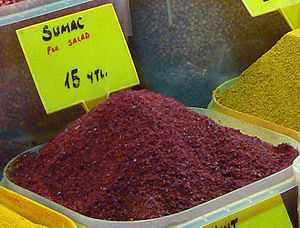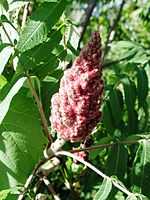Sumac
| Sumac | |
|---|---|
 | |
| Sumac fruit in fall | |
| Scientific classification | |
| Kingdom: | Plantae |
| (unranked): | Angiosperms |
| (unranked): | Eudicots |
| (unranked): | Rosids |
| Order: | Sapindales |
| Family: | Anacardiaceae |
| Subfamily: | Anacardioideae |
| Genus: | Rhus (syn. Searsia) L.[1] |
| Type species | |
| Rhus coriaria L.[2] | |
| Species | |
|
About 250 species; see text | |
Sumac (/ˈsjuːmæk/ or /ˈʃuːmæk/; also spelled sumach) is any one of approximately 250 species of flowering plants in the genus Rhus and related genera, in the family Anacardiaceae. Sumacs grow in subtropical and temperate regions throughout the world, especially in Africa and North America.[3][4]
Sumacs are shrubs and small trees that can reach a height of 1–10 metres (3.3–32.8 ft). The leaves are spirally arranged; they are usually pinnately compound, though some species have trifoliate or simple leaves. The flowers are in dense panicles or spikes 5–30 centimetres (2.0–11.8 in) long, each flower very small, greenish, creamy white or red, with five petals. The fruits form dense clusters of reddish drupes called sumac bobs. The dried drupes of some species are ground to produce a tangy crimson spice.[5][6]
Sumacs propagate both by seed (spread by birds and other animals through their droppings), and by new shoots from rhizomes, forming large clonal colonies.
The word sumac traces its etymology from Old French sumac (13th century), from Mediaeval Latin sumach, from Arabic summāq (سماق), from Syriac summāq (ܣܘܡܩ)- meaning "red."[7]
Cultivation and uses

Species including the Fragrant Sumac (R. aromatica), the Littleleaf Sumac (R. microphylla), the Skunkbush Sumac (R. trilobata), the Smooth Sumac and the Staghorn Sumac are grown for ornament, either as the wild types or as cultivars.
Spice and beverage flavoring
The fruits (drupes) of the genus Rhus are ground into a reddish-purple powder used as a spice in Middle Eastern cuisine to add a lemony taste to salads or meat.[5] In Arab cuisine, it is used as a garnish on meze dishes such as hummus and is added to salads in the Levant. In Iranian (Persian and Kurdish) cuisine, sumac is added to rice or kebab. In Jordanian and Turkish cuisine, it is added to salad-servings of kebabs and lahmacun. Rhus coriaria is used in the spice mixture za'atar.[8][9]
In North America, the Smooth Sumac (R. glabra) and the Staghorn Sumac (R. typhina) are sometimes used to make a beverage termed "sumac-ade," "Indian lemonade" or "rhus juice". This drink is made by soaking the drupes in cool water, rubbing them to extract the essence, straining the liquid through a cotton cloth and sweetening it. Native Americans also used the leaves and drupes of the Smooth and Staghorn Sumacs combined with tobacco in traditional smoking mixtures.
Candlewax
In East Asia, in particular in Japan, traditional candle fuel was produced from Rhus verniciflua and Rhus succedanea (synonym of Toxicodendron succedaneum), among other sumac plants, rather than beeswax or animal fats. The sumac wax was a byproduct of traditional Japanese lacquer manufacture. The conical rousoku candles produced from sumac wax burn with smokeless flame and were favored in many respects over candles made from lard or beeswax during the Tokugawa shogunate. The Japan wax itself is not a true wax but a solid fat that contains 10-15% palmitin, stearin, and olein with about 1% japanic acid (1,21-heneicosanedioic acid). It is still used in many tropical and subtropical countries in the production of wax match sticks.
Dye and tanning agent
The leaves of certain sumacs yield tannin (mostly pyrogallol-type), a substance used in vegetable tanning. Notable sources include the leaves of R. coriaria, Chinese gall on R. chinensis, and wood and roots of R. pentaphylla. Leather tanned with sumac is flexible, light in weight, and light in color. One type of leather made with sumac tannins is morocco leather.[10]
Medicinal use
Sumac was used as a treatment for half a dozen different ailments in medieval medicine, primarily in Middle-Eastern countries (where sumac was more readily available than in Europe). An 11th-century shipwreck off the coast of Rhodes, excavated by archeologists in the 1970s, contained commercial quantities of sumac drupes. These could have been intended for use as medicine, or as a culinary spice, or as a dye.[11] Staghorn sumac is a powerful antioxidant, with ORAC rating over 1500 μmol TE/g.[12]
Other uses
Some beekeepers use dried sumac bobs as a source of fuel for their smokers.[13]
Sumac stems also have a soft pith in the center that is useful in traditional native American pipemaking. They were commonly used as pipe stems in the northern United States.[14]
Dried sumac wood fluoresces under long-wave ultraviolet radiation, commonly known as black light.[15]
Toxicity and control
Some species, such as Poison ivy (Rhus toxicodendron, syn.Toxicodendron radicans), Poison oak (Rhus diversiloba, syn. Toxicodendron diversilobum) and Poison sumac (Rhus vernix, syn. Toxicodendron vernix), have the allergen urushiol and can cause severe allergic reactions. Poison sumac may be identified by its white drupes.
Mowing of sumac is not a good control measure, since the wood is springy, resulting in jagged, sharp pointed stumps when mowed. The plant will quickly recover with new growth after mowing.[16] Goats have long been considered an efficient and quick removal method as they eat the bark, which helps prevent new shoots.
Taxonomy






At times Rhus has held over 250 species. Recent molecular phylogeny research suggests breaking Rhus sensu lato into Actinocheita, Baronia, Cotinus, Malosma, Searsia, Toxicodendron, and Rhus sensu stricto. If this is done, about 35 species would remain in Rhus. However, the data are not yet clear enough to settle the proper placement of all species into these genera.[17][18]
Selected species
|
|
See also
- List of Southern African indigenous trees
- Za'atar
References
- ↑ "Rhus L.". Germplasm Resources Information Network. United States Department of Agriculture. 2009-11-23. Retrieved 2010-02-09.
- ↑ "Rhus L.". TROPICOS. Missouri Botanical Garden. Retrieved 2010-02-09.
- ↑ 12. Rhus Linnaeus, Flora of China
- ↑ Rhus L., USDA PLANTS
- ↑ 5.0 5.1 Sumac is also used as a tea substitute by boiling the dried leaves.Sumac - Ingredients - Taste.com.au
- ↑ Poison Sumach and Good Sumac Shrubs
- ↑ Etymology of Sumac at Etymonline.com and also at and . Etymology of Rhus at Quattrocchi, Umberto (2000). CRC World Dictionary of Plant Names: Common Names, Scientific Names, Eponyms, Synonyms, and Etymology. IV R-Z. Taylor & Francis US. p. 2306. ISBN 978-0-8493-2678-3.
- ↑ Christine Manfield, Charlie Trotter, Ashley Barber -Spice 2008 - Page 28 "Sumac This reddish ground spice is made from the berries of the sumac bush,"
- ↑ Aliza Green Field Guide to Herbs & Spices: How to Identify, Select, and Use ... 2006 - Page 257 "In Lebanon, Syria, and Egypt, sumac is cooked with water to a thick sour paste, which is added to meat and vegetable dishes; this method was also common in Roman times. Sumac appears in the Jordanian spice mixture za'atar (page 288) ..."
- ↑ Davis, Charles T. The Manufacture of Leather. Pub: Henry Carey Baird 1885. May be downloaded from: http://archive.org/details/manufactureoflea01davi
- ↑ George Fletcher Bass; James W. Allan (2003). Serçe Limanı: An Eleventh-century Shipwreck. Texas A&M University Press. p. 506. ISBN 978-0-89096-947-2.
- ↑ "Evaluation of antioxidant activities and chemical characterisation of staghorn sumac fruit (Rhus hirta L.).".
- ↑ Avitabile, Alphonse. Sammataro, Diana. The Beekeeper's Handbook. Publisher: Comstock 1998. ISBN 978-0801485039
- ↑ Lewis, Thomas H. The Medicine Men: Oglala Sioux Ceremony and Healing. Publisher: University of Nebraska Press. 1992. ISBN 978-0803279391
- ↑ Hoadley, R. Bruce (2000). "Chapter 5: Other Properties of Wood". Understanding Wood: a Craftsman's Guide to Wood Technology (2 ed.). Taunton Press. pp. 105–107. ISBN 978-1-56158-358-4.
- ↑ Ortmann, John; Katherine L. Miles; James Stubbendieck; Walter H. Schacht (2000). Management of Smooth Sumac on Grasslands. University of Nebraska-Lincoln.
- ↑ Miller, Allison J.; David A. Young; Jun Wen (2001). "Phylogeny and Biogeography of Rhus (Anacardiaceae) Based on ITS Sequence Data". International Journal of Plant Sciences 162 (6): 1401–1407. doi:10.1086/322948.
- ↑ Pell, Susan Katherine (2004-02-18). Molecular Systematics of the Cashew Family (Anacardiaceae). Louisiana State University. pp. 103–108.
- ↑ Miller, A. 2004. Rhus sp. nov. A. 2006 IUCN Red List of Threatened Species. Downloaded on 23 August 2007.
Bibliography
- RO Moffett. A Revision of Southern African Rhus species FSA (Flora of South Africa) vol 19 (3) Fascicle 1.
- Ernst Schmidt; Mervyn Lötter, Warren McCleland (2002). Trees and Shrubs of Mpumalanga and Kruger National Park. Jacana Media. ISBN 978-1-919777-30-6.
External links
| Wikimedia Commons has media related to Rhus. |
| Wikispecies has information related to: Rhus |